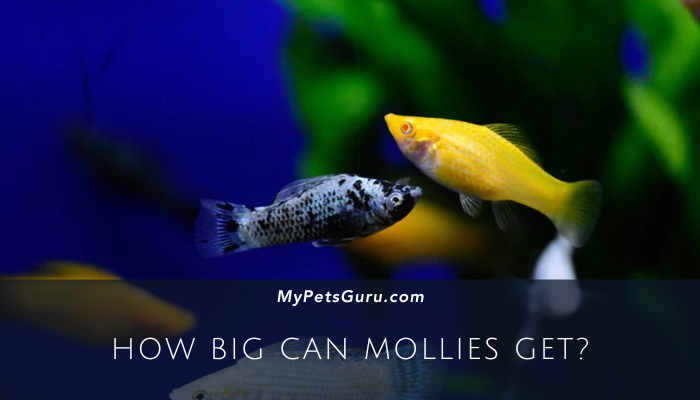Mollies, those small and vibrant fish you often see swimming gracefully in fish tanks, can actually grow quite large given the right conditions. If you’re considering adding mollies to your aquarium, it’s essential to understand how big they can get and what factors influence their growth. In this article, we’ll explore the maximum size mollies can reach, the factors that determine their growth rate, and how you can create an optimal environment for these fascinating creatures.
Understanding the Molly’s Maximum Size
Mollies typically fall into two main categories: the short-finned mollies and the sailfin mollies. Each category contains various species with varying growth patterns, but on average, mollies can reach a size of 3 to 4 inches. However, some species, such as the sailfin molly (Poecilia latipinna), can grow up to an impressive 6 inches in length.
The maximum size of mollies is influenced by a combination of genetic factors and environmental conditions. Mollies that come from a line of larger ancestors will generally have a higher potential for growth. Additionally, providing a suitable habitat with ample space and proper nutrition can encourage their growth to reach their maximum potential.
Factors Affecting the Growth Rate of Mollies
Several factors contribute to the growth rate of mollies. Understanding these factors will help you create an environment that promotes healthy growth and allows your mollies to thrive:
1. Water Quality
Water quality plays a crucial role in the growth of mollies. They prefer slightly alkaline water with a temperature between 75 and 82 degrees Fahrenheit. Maintaining proper pH levels and ensuring good water circulation and filtration will help create an optimal environment for their growth.
2. Diet
A well-balanced diet is essential for the growth and overall health of mollies. They are omnivorous, meaning they eat both plant matter and small invertebrates. Providing a varied diet that includes high-quality flake food, pellets, and occasional live or frozen foods will help meet their nutritional needs and contribute to their growth.
3. Tank Size and Space
Mollies are active swimmers and appreciate ample space to move around. A larger tank with plenty of swimming room will allow them to exercise, which in turn can promote their growth. At a minimum, a tank size of 20 gallons is recommended for a small group of mollies.
4. Genetics
The genetics of mollies play a role in their maximum potential size. Breeding mollies from lines with naturally larger individuals can increase the likelihood of producing offspring that reach their maximum growth potential. However, it’s important to note that genetic factors alone cannot guarantee a larger size if other environmental conditions are not met.
Creating an Optimal Environment for Mollies
To ensure your mollies reach their maximum potential size, it’s essential to provide them with a suitable environment that meets their specific needs. Here are some tips to create an optimal habitat:
-
Tank Setup: Set up a well-maintained aquarium with proper filtration and heating systems. Make sure to provide hiding spots with plants or ornaments to mimic their natural habitat.
-
Water Parameters: Maintain a stable water temperature between 75 and 82 degrees Fahrenheit and a pH level between 7.5 and 8.5. Regularly test the water quality and perform appropriate water changes when needed.
-
Proper Nutrition: Feed your mollies a balanced diet consisting of high-quality flake food, pellets, and occasional live or frozen foods. Avoid overfeeding to prevent health issues.
-
Tank Size: Provide a tank large enough to accommodate the number of mollies you plan to keep. A larger tank with ample swimming space will contribute to their growth and well-being.
-
Compatibility: Choose tank-mates that are compatible with mollies. Avoid aggressive species that may bully or stress out the mollies, which can hinder their growth.
By following these guidelines, you can create a thriving environment for your mollies and give them the best chance to reach their maximum size.
Frequently Asked Questions (FAQs)
How long do mollies take to reach their maximum size?
Mollies reach their maximum size typically within the first year of their lives. However, individual growth rates may vary depending on genetic and environmental factors.
Can mollies grow larger than 6 inches?
While the average maximum size for most mollies is around 3 to 4 inches, certain species like the sailfin molly can grow up to 6 inches in length.
Do female and male mollies grow to the same size?
In general, male mollies tend to be smaller than females. Female mollies have a more robust body shape and can grow slightly larger than their male counterparts.
Can I keep mollies in a community tank?
Yes, mollies are generally peaceful fish and can be kept in a community tank with other compatible species. However, it’s important to consider the size of the tank and the behavior of the other fish to ensure a harmonious environment.
How big of a tank do I need for a molly?
A tank size of at least 20 gallons is recommended for a small group of mollies. However, a larger tank with more swimming space will be more favorable for their growth and overall well-being.
In conclusion, mollies have the potential to grow to a significant size if provided with the right conditions. The maximum size of mollies can range from 3 to 4 inches, with some species reaching up to 6 inches. Factors such as water quality, diet, tank size, and genetics all play a crucial role in their growth rate. By creating an optimal environment and meeting their specific needs, you can ensure your mollies thrive and reach their maximum potential size.

Hi, I’m Lila Hart, and I’m just as fish-obsessed as they come! I’ve been enamored with aquatic life since I was a little kid. Now, I’m a marine biologist with over 3 years of hands-on experience in the world of pet fish.
I’ve learned the ropes of fishkeeping through trial and error, and I’m excited to share my knowledge with you. My mission is to help you create a thriving aquatic paradise for your finned companions. Together, we’ll explore the fascinating underwater world of pet fish!

